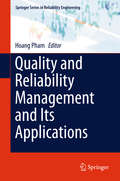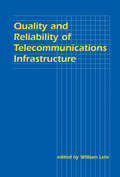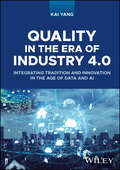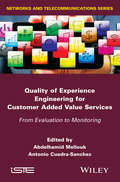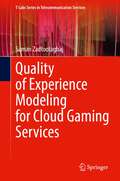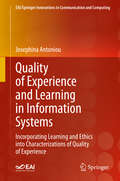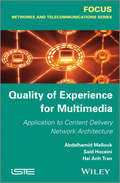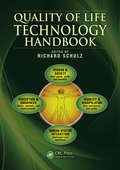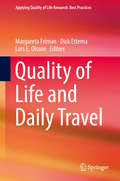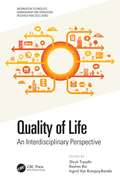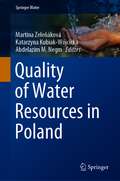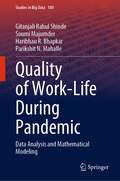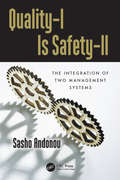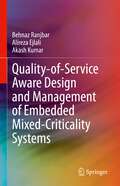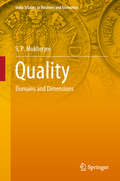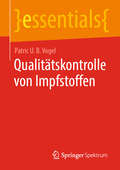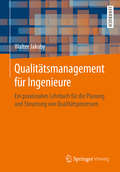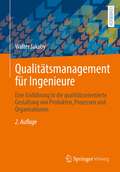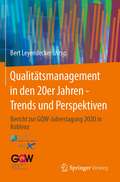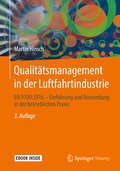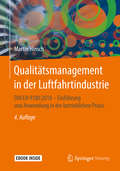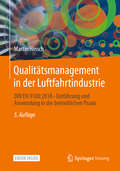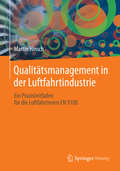- Table View
- List View
Quality and Reliability Management and Its Applications
by Hoang PhamIntegrating development processes, policies, and reliability predictions from the beginning of the product development lifecycle to ensure high levels of product performance and safety, this book helps companies overcome the challenges posed by increasingly complex systems in today's competitive marketplace. Examining both research on and practical aspects of product quality and reliability management with an emphasis on applications, the book features contributions written by active researchers and/or experienced practitioners in the field, so as to effectively bridge the gap between theory and practice and address new research challenges in reliability and quality management in practice. Postgraduates, researchers and practitioners in the areas of reliability engineering and management, amongst others, will find the book to offer a state-of-the-art survey of quality and reliability management and practices.
Quality and Reliability of Telecommunications Infrastructure: Quality And Reliability Of Telecommunications Infrastructure (LEA Telecommunications Series)
by William LehrIn the last decade, the technology, regulation, and industry structure of our information infrastructure (telephone services, cable and broadcast television, and myriad new data and information services) have changed dramatically. Since the break-up of AT&T's Bell System monopoly, telephone services in the United States are no longer purchased from a single firm. Advances in fiber optics, wireless communications and software-controlled switching are changing how communication services are provided. As the global economy grows more dependent on a hybrid mix of interconnected networks, public officials in the US and abroad are relinquishing control of the market. All of these changes are affecting the quality and reliability of the telecommunications infrastructure, but informed discussions of the public policy and economic issues are scarce. Deregulation and increased competition have lowered prices, but have service quality and reliability suffered? Do advanced network technologies which make it possible to offer a dizzying array of new services increase vulnerability to system-wide failures? Who should or is likely to bear the costs of increased -- or decreased -- service quality? This volume tackles the economic and public policy issues raised by these difficult questions for an audience of industry executives, scholars, and policymakers. Leading scholars and analysts examine such issues as the effects of network ownership on incentives to invest in quality improvements and/or strategies for quality-differentiated pricing in tomorrow's broadband, integrated networks. They analyze the quality of current telecommunications networks and the impact of re-regulation on cable television quality. The contributions range from new microeconomic theory to new empirical research. As such, the volume makes a valuable contribution to the public debate on network quality and reliability. It will be useful both as an introduction to newcomers and as a resource for more experienced researchers. As regulatory, industry and national barriers to integrated communications fall, these issues are likely to become even more important. The research presented here provides a solid foundation for further discussion.
Quality in the Era of Industry 4.0: Integrating Tradition and Innovation in the Age of Data and AI
by Kai YangQUALITY IN THE ERA OF INDUSTRY 4.0 Enables readers to use real-world data from connected devices to improve product performance, detect design vulnerabilities, and design better solutions Quality in the Era of Industry 4.0 provides an insightful guide to harnessing user performance and behavior data through AI and other Industry 4.0 technologies. This transformative approach enables companies to not only optimize products and services in real-time, but also to anticipate and mitigate likely failures proactively. In a succinct and lucid style, the book presents a pioneering framework for a new paradigm of quality management in the Industry 4.0 landscape. It introduces groundbreaking techniques such as utilizing real-world data to tailor products for superior fit and performance, leveraging connectivity to adapt products to evolving needs and use-cases, and employing cutting-edge manufacturing methods to create bespoke, cost-effective solutions with greater efficiency. Case examples featuring applications from the automotive, mobile device, home appliance, and healthcare industries are used to illustrate how these new quality approaches can be used to benchmark the product’s performance and durability, maintain smart manufacturing, and detect design vulnerabilities. Written by a seasoned expert with experience teaching quality management in both corporate and academic settings, Quality in the Era of Industry 4.0 covers topics such as: Evolution of quality through industrial revolutions, from ancient times to the first and second industrial revolutions Quality by customer value creation, explaining differences in producers, stakeholders, and customers in the new digital age, along with new realities brought by Industry 4.0 Data quality dimensions and strategy, data governance, and new talents and skill sets for quality professionals in Industry 4.0 Automated product lifecycle management, predictive quality control, and defect prevention using technologies like smart factories, IoT, and sensors Quality in the Era of Industry 4.0 is a highly valuable resource for product engineers, quality managers, quality engineers, quality consultants, industrial engineers, and systems engineers who wish to make a participatory approach towards data-driven design, economical mass-customization, and late differentiation.
Quality of Experience Engineering for Customer Added Value Services: From Evaluation to Monitoring
by Abdelhamid Mellouk Antonio Cuadra-SanchezThe main objective of the book is to present state-of-the-art research results and experience reports in the area of quality monitoring for customer experience management, addressing topics which are currently important, such as service-aware future Internet architecture for Quality of Experience (QoE) management on multimedia applications. In recent years, multimedia applications and services have experienced a sudden growth. Today, video display is not limited to the traditional areas of movies and television on TV sets, but these applications are accessed in different environments, with different devices and under different conditions. In addition, the continuous emergence of new services, along with increasing competition, is forcing network operators and service providers to focus all their efforts on customer satisfaction, although determining the QoE is not a trivial task. This book addresses the QoE for improving customer perception when using added value services offered by service providers, from evaluation to monitoring and other management processes.
Quality of Experience Modeling for Cloud Gaming Services (T-Labs Series in Telecommunication Services)
by Saman ZadtootaghajThis book presents the development of a gaming quality model to predict the gaming Quality of Experience (QoE) of players that could be used for planning the network service or quality monitoring of cloud gaming services. The author presents a model that is developed following a modular structure approach that keeps the different types of impairments separately. The book shows how such a modular structure allows developing a sustainable model as each component can be updated by advances in that specific research area or technology. The presented gaming quality model takes into account two modules of video quality and input quality. The latter considers the interactivity aspects of gaming. The video quality module offers a series of models that differ depending on the level of access to the video stream information, allowing high flexibility for service providers regarding the positions of measuring points within their system. In summary, the present book focuses on (1) creation of multiple image/video and cloud gaming quality datasets, (2) development of a gaming video classification, and (3) development of a series of gaming QoE models to predict the gaming QoE depending on the level of access to the video stream information.
Quality of Experience and Learning in Information Systems: Incorporating Learning and Ethics into Characterizations of Quality of Experience (EAI/Springer Innovations in Communication and Computing)
by Josephina AntoniouThe book shows how researchers, practitioners, and designers can improve user experiences with technology by understanding various user learning styles and characteristics when they interact with new and challenging applications and interfaces. Quality of experience in this new technological environment is affected by the learning curve involved in being able to use the new interfaces in a satisfactory way. The author explores the variations in quality of experience when considering learning and ethics when interacting with new, emerging technologies. The author shows how results can be applied to technologies such as big data, AI, 5G, and Internet of Things (IoT). Taken into account are also safety and security requirements, context, environment, etc. The book explores the idea of learning, ethics, and the idea that there exists a “recipe” for a satisfactory interaction with technology if such relevant parameters are taken into consideration.Analyzes user habits to improve quality of experience when interacting with technology;Shows how to apply quality of service techniques to 5G, IoT, big data and AI;Uses behavior models to analyze interactions to improve the user quality of experience.
Quality of Experience for Multimedia: Application to Content Delivery Network Architecture
by Abdelhamid Mellouk Said Hoceini Hai Anh TranBased on a convergence of network technologies, the Next Generation Network (NGN) is being deployed to carry high quality video and voice data. In fact, the convergence of network technologies has been driven by the converging needs of end-users.The perceived end-to-end quality is one of the main goals required by users that must be guaranteed by the network operators and the Internet Service Providers, through manufacturer equipment. This is referred to as the notion of Quality of Experience (QoE) and is becoming commonly used to represent user perception. The QoE is not a technical metric, but rather a concept consisting of all elements of a user's perception of the network services. The authors of this book focus on the idea of how to integrate the QoE into a control-command chain in order to construct an adaptive network system. More precisely, in the context of Content-Oriented Networks used to redesign the current Internet architecture to accommodate content-oriented applications and services, they aim to describe an end-to-end QoE model applied to a Content Distribution Network architecture. About the Authors Abdelhamid Mellouk is Full Professor at University of Paris-Est C-VdM (UPEC), Networks & Telecommunications (N&T) Department and LiSSi Laboratory, France. Head of several executive national and international positions, he was the founder of the Network Control Research activity at UPEC with extensive international academic and industrial collaborations. His general area of research is in adaptive real-time control for high-speed new generation dynamic wired/wireless networks in order to maintain acceptable Quality of Service/Experience for added-value services. He is an active member of the IEEE Communications Society and has held several offices including leadership positions in IEEE Communications Society Technical Committees.Said Hoceini is Associate Professor at University of Paris-Est C-VdM (UPEC), Networks & Telecommunications (N&T) Department and LiSSi Laboratory, France. His research focuses on routing algorithms, quality of service, quality of experience, and wireless sensor networks, as well as bio-inspired artificial intelligence approaches. His work has been published in several international conferences and journals and he serves on several TPCs.Hai Anh Tran is Associate Professor at the Hanoi University of Science and Technology (HUST), Vietnam. His research focuses on QoE aspects, QoS adaptive control/command mechanisms, wired routing, as well as bio-inspired artificial intelligence approaches.
Quality of Life Technology Handbook (Rehabilitation Science in Practice Series)
by Richard SchulzA collaboration between leading scientists, practitioners, and researchers at Carnegie-Mellon University and the University of Pittsburgh, this book is a comprehensive resource describing Quality of Life technologies and their development, evaluation, adoption, and commercialization. It takes an interdisciplinary team approach to the process of tec
Quality of Life and Daily Travel (Applying Quality Of Life Research Ser.)
by Dick Ettema Margareta Friman Lars E. OlssonThis volume analyses the relevance of daily travel in the quality of life of individuals. It provides a broad understanding of the links between life satisfaction, well-being and travel, the importance of commuting, and different evaluations and measures to assess the experience of commuting and quality of life. Chapters in this book relate travel and quality of life to the built environment, accessibility and exclusion, travel mode choice, travel satisfaction and emotions. It brings together distinguished researchers from a variety of academic backgrounds providing conceptualizations and applications, presented as case studies, for daily travel and well-being. Findings presented in this book are highly relevant for transport planners, transport marketers, public transport authorities, and environmental professionals in the pursuit of improving people’s life.
Quality of Life: An Interdisciplinary Perspective (Information Technology, Management and Operations Research Practices)
by Shruti Tripathi Rashmi Rai Ingrid Van Rompay-BartelsQuality of Life: An Interdisciplinary Perspective presents the Quality of Life using a contemporary and interdisciplinary approach. Various socio-cultural, spiritual, technological, and human factors aspects, which have an immense bearing on our lives, are an integral part of this book. This book highlights cultural differences in terms of Quality of Life. It recognizes the presence of cultural differences resulting from the social status attributed to an individual’s age, gender, class, race, and ethnicity. It can be used as a guide in the field of global well-being and for future research. It presents clues to complex problems and empirical materials, and attempts to bring out a more comprehensive picture of global and contemporary Quality of Life and well-being. This book can also fill a gap in teaching and research. Those who will find this book useful are researchers, academicians, practitioners, and students of management, behavioral science, human factors, psychology, health economics, sociology, public health, and politics.
Quality of Synthetic Speech
by Florian HinterleitnerThis book reviews research towards perceptual quality dimensions of synthetic speech, compares these findings with the state of the art, and derives a set of five universal perceptual quality dimensions for TTS signals. They are: (i) naturalness of voice, (ii) prosodic quality, (iii) fluency and intelligibility, (iv) absence of disturbances, and (v) calmness. Moreover, a test protocol for the efficient indentification of those dimensions in a listening test is introduced. Furthermore, several factors influencing these dimensions are examined. In addition, different techniques for the instrumental quality assessment of TTS signals are introduced, reviewed and tested. Finally, the requirements for the integration of an instrumental quality measure into a concatenative TTS system are examined.
Quality of Water Resources in Poland (Springer Water)
by Martina Zeleňáková Abdelazim M. Negm Katarzyna Kubiak-WójcickaThis book presents state-of-the-art knowledge concerning water quality in Poland. It offers a wide variety of cases and issues on water resource quality management. The book also presents different methods and strategies to effectively use the most advanced water resource quality problems such as water pollution, whether physical, chemical, or biological, of surface water resources and groundwater resources.The authors pay exceptional attention to water quality monitoring in agricultural, urban catchments, and water reservoirs. More light into the water quality is required to assess water's physicochemical status accurately and plan suitable protection actions against recognized threats.This book addresses the needs of professional engineers, researchers, policy planners, decision-makers, stakeholders, and anyone looking to learn more about the quality situation of water resources in Poland and other similar countries and regions.
Quality of Work-Life During Pandemic: Data Analysis and Mathematical Modeling (Studies in Big Data #100)
by Parikshit N. Mahalle Gitanjali Rahul Shinde Soumi Majumder Haribhau R. BhapkarThis book is focused on the impact of the COVID-19 pandemic on different sectors, i.e., education, real estate, health, and agriculture. The lockdown has been announced to control the spread of COVID-19 infections, however people/industries/organizations were not ready for lockdown and it has greatly affected their growth. The front workers in the healthcare sector suffered a lot as major responsibilities they needed to carry on. The education sector is also hampered due to the pandemic as schools, colleges were closed and teaching, examinations were carried out on online platforms. These platforms were new to teachers as well as students. The real estate sector faced tremendous loss in this pandemic as people were scared and no one ready to invest their money in such an uncertain time. The agriculture filed is also suffered as raw materials required for agriculture were not available readily due to pandemic. This book presents a survey that is conducted to understand the impact of COVID-19 on the quality of work-life in various sectors. The survey is focused majorly on four sectors, i.e. education, healthcare, real estate and agriculture. Data analysis is done based on responses of survey and mathematical modeling is provided for each case study.
Quality-I Is Safety-ll: The Integration of Two Management Systems (Developments in Quality and Safety)
by Sasho AndonovThis book deals with the present and future situation with Quality and Safety management Systems (QMS and SMS). It presents new ideas, points to the basic misunderstandings in the two management systems, and covers a wide range of industries, as well as providing a practical assessment of scientific theory. It explains the fundamental misunderstanding of what Quality and Safety is from a practical point of view and how to improve them by integrating the two systems from the perspective that Quality-I is Safety-II.
Quality-of-Service Aware Design and Management of Embedded Mixed-Criticality Systems
by Akash Kumar Behnaz Ranjbar Alireza EjlaliThis book addresses the challenges associated with efficient Mixed-Criticality (MC) system design. We focus on application analysis through execution time analysis and task scheduling analysis in order to execute more low-criticality tasks in the system, i.e., improving the Quality-of-Service (QoS), while guaranteeing the correct execution of high-criticality tasks. Further, this book addresses the challenge of enhancing QoS using parallelism in multi-processor hardware platforms.
Quality: Domains and Dimensions (India Studies in Business and Economics)
by S. P. MukherjeeThis book offers a comprehensive overview of quality and quality management. It also explores total quality management, covering its human, technological and analytical imperatives. It also examines quality systems and system standards, highlighting essential features and avoiding a reproduction of the ISO 9000 standard, as well as people-related issues in implementing a quality system. A holistic understanding of quality considerations, which now permeate every aspect of human life, should guide related policies, plans and practices. The book describes the all-pervasive characteristics of quality, putting together diverse definitions of "quality," outlining its different dimensions, and linking it with reliability and innovation. It goes on to assess the quality of measurements in terms of precision, accuracy and uncertainty and discusses managing quality with a focus on business performance. This is followed by a chapter on improving process quality, which is the summum bonum of quality management, and a chapter addressing the crucial problem of measuring customer satisfaction through appropriate models and tools. Further, it covers non-traditional subjects such as quality of life, quality of working life, quality assurance and improvement in education, with special reference to higher education, quality in research and development and characterizes the quality-related policies and practices in Indian industry. The last chapter provides a broad sketch of some recent advances in statistical methods for quality management. Along with the research community, the book’s content is also useful for practitioners and industry watchers.
Qualitätskontrolle von Impfstoffen (essentials)
by Patric U. VogelIn diesem Buch wird die Qualitätskontrolle von Impfstoffen dargestellt. Hierzu zählen neben der Durchführung von analytischen Prüfungen verschiedenste qualitätsrelevante Aufgaben, z.B. die Festlegung von Qualitätsanforderungen, die Analyse von unerwarteten Ergebnissen oder Stabilitätsuntersuchungen, die die Qualitätskontroll-Einheit erfüllen muss. Die Abläufe sind hochreguliert und dienen der Patientensicherheit. Es gibt aber auch Beispiele, bei denen trotz erfolgreicher Qualitätskontrolle Qualitätsmängel möglich sind, die Schaden verursachen können.
Qualitätsmanagement für Ingenieure: Ein praxisnahes Lehrbuch für die Planung und Steuerung von Qualitätsprozessen
by Walter JakobyDie Methoden des QM und der Aufbau von ISO-9001-QMS werden in diesem Werk praxisnah vermittelt. Die elementaren Methoden dienen zum Lösen von Problemen, sowie zur Erfassung, Darstellung und Auswertung von Messreihen. Statistische Methoden wie SPC und die QRK ermöglichen den Umgang mit großen Produkt-Stückzahlen. QFD, FMEA und Poka Yoke unterstützen die anforderungsgerechte Gestaltung von Produkten und Prozessen. Anschließend wird beschrieben, wie aus vielen Einzelmethoden ein durchgängiges, ISO-9001-zertifiziertes QMS aufgebaut werden kann. Abschließend werden Six Sigma, Total Quality Management und Lean Management erläutert, die das Management von Unternehmen in qualitätsorientierter Sicht ausrichten.
Qualitätsmanagement für Ingenieure: Eine Einführung in die qualitätsorientierte Gestaltung von Produkten, Prozessen und Organisationen
by Walter JakobyDas Lehrbuch behandelt anschaulich und praxisnah die QM-Grundlagen. Alle wichtigen Methoden werden verständlich erklärt und in realistischen Beispielen angewendet. Das Buch beantwortet wichtige Fragen: Was ist Qualität? Wie kann sie erreicht werden? Das vorgestellte Methodenspektrum reicht vom Lösen von Problemen und zum Umgang mit Messdaten, über statistische Methoden der Qualitätsprüfung bis hin zur anforderungsgerechten Gestaltung der Produkte und Prozesse. Es wird gezeigt, wie aus den Einzelmethoden ein zertifiziertes QMS aufgebaut werden kann und wie sich ganze Unternehmen qualitätsorientiert ausrichten lassen.Das Buch ist für die vorlesungsbegleitende Verwendung, aber auch für das Selbststudium geeignet. Zusätzliche online-Unterlagen unterstützen die Einarbeitung und Anwendung.
Qualitätsmanagement in den 20er Jahren - Trends und Perspektiven: Bericht zur GQW-Jahrestagung 2020 in Koblenz
by Bert LeyendeckerZielsetzung der Gesellschaft für Qualitätswissenschaft e.V. ist es, die Qualitätswissenschaft in Lehre und Forschung zu fördern und den Wissenstransfer in die industrielle Anwendung zu unterstützen. Geschehen soll dies unter anderem durch Pflege des wissenschaftlichen Erfahrungsaustauschs unter den auf diesem Gebiet tätigen Personen und Institutionen und der Verbreitung von Forschungs- und Entwicklungsergebnissen sowie der Unterstützung des Wissenstransfers zwischen Forschung und Praxis. Unter dem Leitthema „Qualitätsmanagement in den 20er Jahren - Trends und Perspektiven“ hat die Gesellschaft für Qualitätsmanagement gemeinsam mit der Hochschule Koblenz zur GQW Tagung 2020 eingeladen. Wir freuen uns, dass wir Ihnen nun den zugehörigen Tagungsband vorstellen können. Wenn man nach den Trends der kommenden Jahre fragt, muss in vielen Branchen und Disziplinen fast zwingend die Digitalisierung genannt werden. So bildet dieses Thema auch einen starken Schwerpunkt in diesem Tagungsband. Die Beiträge beschäftigen sich mit künstlicher Intelligenz beim autonomen Fahren, der Rolle der Digitalisierung bei Nachweissystemen für Zusatzqualifikationen und Zutrittszertifikaten sowie der Integration von Industrie 4.0-Elementen in ganzheitlichen Produktionssystemen. Auch die Frage, welche Rolle die Blockchain-Technologie im Qualitätsmanagement spielen könnte, wird betrachtet. Eine weitere Facette bildet der Beitrag über den Einsatz von Eye-Tracking in der Produktentwicklung. Die aktuelle Corona-Krise wird ebenfalls aufgegriffen und erste Analysen zum Einfluss des digitalen Reifegrads auf das Arbeitszeitmodell in Krisenzeiten vorgestellt. Aber auch Beiträge zur Rolle von Erfahrungswissen im Qualitätsmanagement, zur Messung der Qualität in Produkt-Service-Systemen, zur ganzheitlichen Fehleranalyse, zu geometrischen Produktspezifikationen und Montagereihenfolgen finden Sie in diesem Band. Ein breiter Kanon spannender und aktueller Themen also, der zur Diskussion über das Qualitätsmanagement von morgen einlädt.
Qualitätsmanagement in der Luftfahrtindustrie
by Martin HinschDie Europäische Norm EN 9100 ist die branchenspezifische Norm der Luftfahrt-, Raumfahrt- und Verteidigungsindustrie. Für die Zusammenarbeit mit einem Luftfahrtkonzern gilt eine Zertifizierung der Zulieferer nach dieser Norm i.d.R. als obligatorisch.Das Buch unterstützt beim Verständnis und bei der betrieblichen Implementierung der Norm oder beim Umstieg von der ISO 9001 auf die EN 9100:2016. Nach einer Heranführung an die ISO 9001 im Allgemeinen und der EN 9100 im Speziellen wird auf die Schwerpunkte und Kerncharakteristika der EN 9100:2016 eingegangen. Das Buch richtet den Blickwinkel vor allem auf die Erläuterung und die Übersetzung des Normentextes in die Sprache des betrieblichen Alltags. Der Aufbau des Werkes orientiert sich dazu exakt am Aufbau der EN 9100:2016. Zahlreiche Praxisbeispiele erleichtern das Verständnis und die Implementierung im eigenen Unternehmen. Abschließend geht der Autor detailliert auf den Ablauf des Zertifizierungsprozesses ein. Dazu gehören die Vorbereitung, die Auswahl eines Zertifizierungsauditors und eines Zertifizierungsinstituts, die Auditdurchführung einschließlich Prozessmessung, die Abarbeitung von Beanstandungen sowie die Zertifikatsausstellung. Aufgrund hoher Deckungsgleichheit zwischen den Normen eignet sich dieses Buch auch als Ratgeber für die EN 9110 für Instandhaltungsbetriebe und die EN 9120 für Händler und Lagerhalter. In der 3. Auflage dieses erfolgreichen Ratgebers für die Luftfahrtindustrie sind bereits die Zertifizierungserfahrungen und Umsetzungsherausforderungen im Bereich der EN 9100:2016berücksichtigt. Des Weiteren wurden neue praktische Tipps für ein erfolgreiches Zertifizierungsaudit aufgenommen.
Qualitätsmanagement in der Luftfahrtindustrie: DIN EN 9100:2018 - Einführung und Anwendung in der betrieblichen Praxis
by Martin HinschDie Europäische Norm EN 9100 ist die branchenspezifische Norm der Luftfahrt-, Raumfahrt- und Verteidigungsindustrie. Für die Zusammenarbeit mit einem Luftfahrtkonzern gilt eine Zertifizierung der Zulieferer nach dieser Norm i.d.R. als obligatorisch.Das Buch unterstützt beim Verständnis und bei der betrieblichen Implementierung der Norm oder beim Umstieg von der ISO 9001 auf die EN 9100:2018. Nach einer Heranführung an die ISO 9001 im Allgemeinen und der EN 9100 im Speziellen wird auf die Schwerpunkte und Kerncharakteristika der EN 9100:2018 eingegangen. Das Buch richtet den Blickwinkel vor allem auf die Erläuterung und die Übersetzung des Normentextes in die Sprache des betrieblichen Alltags. Der Aufbau des Werkes orientiert sich dazu exakt am Aufbau der EN 9100:2018. Zahlreiche Praxisbeispiele erleichtern das Verständnis und die Implementierung im eigenen Unternehmen. Abschließend geht der Autor detailliert auf den Ablauf des Zertifizierungsprozesses ein. Dazu gehören die Vorbereitung, die Auswahl eines Zertifizierungsauditors und eines Zertifizierungsinstituts, die Auditdurchführung einschließlich Prozessmessung, die Abarbeitung von Beanstandungen sowie die Zertifikatsausstellung. Aufgrund hoher Deckungsgleichheit zwischen den Normen eignet sich dieses Buch auch als Ratgeber für die EN 9110 für Instandhaltungsbetriebe und die EN 9120 für Händler und Lagerhalter. In der 4. Auflage dieses erfolgreichen Ratgebers für die Luftfahrtindustrie wurden neue praktische Tipps für ein erfolgreiches Zertifizierungsaudit aufgenommen. Zudem wurden die wichtigsten Anforderungen zur EN 9120 für Händler und Lagerhalter in den Text integriert.Das Werk wendet sich an qualitätsverantwortliche Mitarbeiter bei Zulieferbetrieben der Luftfahrtindustrie.
Qualitätsmanagement in der Luftfahrtindustrie: DIN EN 9100:2018 - Einführung und Anwendung in der betrieblichen Praxis
by Martin HinschDie Europäische Norm EN 9100 ist die branchenspezifische Norm der Luftfahrt-, Raumfahrt- und Verteidigungsindustrie. Für die Zusammenarbeit mit einem Luftfahrtkonzern gilt eine Zertifizierung der Zulieferer nach dieser Norm i.d.R. als obligatorisch.Das Buch unterstützt beim Verständnis und bei der betrieblichen Implementierung der Norm oder beim Umstieg von der ISO 9001 auf die EN 9100:2018. Nach einer Heranführung an die ISO 9001 im Allgemeinen sowie an die EN 9100 und EN 9120 im Speziellen wird auf die Schwerpunkte und Kerncharakteristika der Luftfahrtnormen eingegangen. Das Buch richtet den Blickwinkel vor allem auf die Erläuterung und die Übersetzung des Normentextes in die Sprache des betrieblichen Alltags. Der Aufbau des Werkes orientiert sich dazu exakt am Aufbau der EN 9100:2018. Dazu werden, wo angebracht, auch Besonderheiten der Händlernorm EN 9120 thematisiert. Praxisbeispiele erleichtern das Verständnis und die Implementierung im eigenen Unternehmen. Abschließend geht der Autor detailliert auf den Ablauf des Zertifizierungsprozesses ein. Dazu gehören die Vorbereitung, die Auswahl eines Zertifizierungsauditors und eines Zertifizierungsinstituts, die Auditdurchführung einschließlich Prozessmessung, die Abarbeitung von Beanstandungen sowie die Zertifikatsausstellung. Aufgrund hoher Deckungsgleichheit zwischen den Normen eignet sich dieses Buch auch als Ratgeber für die EN 9110 für Instandhaltungsbetriebe und die EN 9120 für Händler und Lagerhalter. In der 5. Auflage dieses erfolgreichen Ratgebers für die Luftfahrtindustrie wurden praktische Tipps für ein erfolgreiches Zertifizierungsaudit ergänzt und neueste Zertifizierungserfahrungen mit der EN 9100:2018 aufgenommen.
Qualitätsmanagement in der Luftfahrtindustrie: Die EN 9100:2016 verständlich erklärt
by Martin HinschDie 2. Auflage dieses erfolgreichen Ratgebers für die Luftfahrtindustrie erläutert detailliert die Anforderungen der neuen EN 9100:2016 und gibt überdies praktische Tipps für ein erfolgreiches Zertifizierungsaudit.Die Europäische Norm EN 9100 ist die branchenspezifische Norm der Luft-, Raumfahrt- und Verteidigungsindustrie. Für die Zusammenarbeit mit einem Luftfahrtkonzern gilt eine Zertifizierung der Zulieferer nach dieser Norm i.d.R. als obligatorisch.Das Buch unterstützt beim Verständnis und bei der betrieblichen Implementierung der Norm sowie bei der Anpassung an die Anforderungen der neuen EN 9100:2016. Nach einer Heranführung an die ISO 9001 im Allgemeinen und der EN 9100 im Speziellen wird auf die wesentlichen Änderungen der 2016er Normenrevision sowie auf Schwerpunkte und Kerncharakteristika der EN 9100:2016 eingegangen. Das Buch richtet den Blickwinkel vor allem auf die Erläuterung und die Übersetzung des Normentextes in die Sprache des betrieblichen Alltags. Der Aufbau des Werkes orientiert sich dazu exakt am Aufbau der EN 9100:2016. Zahlreiche Praxisbeispiele erleichtern das Verständnis und die Implementierung im eigenen Unternehmen. Jedem Kapitel ist eine Infobox vorangestellt, in der die Änderungen zur alten EN 9100:2009 aufgeführt werden.Abschließend geht der Autor detailliert auf den Ablauf des Zertifizierungsprozesses ein. Dazu gehören die Vorbereitung, die Auswahl eines Zertifizierungsauditors und eines Zertifizierungsinstituts, die Auditdurchführung einschließlich Prozessmessung, die Abarbeitung von Beanstandungen sowie die Zertifikatsausstellung. Aufgrund hoher Deckungsgleichheit zwischen den Normen eignet sich dieses Buch auch als Ratgeber für die neue EN 9110 und EN 9120.
Qualitätsmanagement in der Luftfahrtindustrie: Ein Praxisleitfaden für die Luftfahrtnorm EN 9100
by Martin HinschDie Europäische Norm EN 9100 ist die branchenspezifische Norm der Luft-, Raumfahrt- und Verteidigungsindustrie. Für die Zusammenarbeit mit einem Luftfahrtkonzern gilt eine Zertifizierung der Zulieferer nach dieser Norm i.d.R. als obligatorisch.Das Buch unterstützt beim Verständnis und bei der betrieblichen Implementierung der Norm. Nach einer Heranführung an die Grundlagen von Zertifizierungen nach ISO 9001 im Allgemeinen und der EN 9100 im Speziellen werden die Schwerpunkte und Kerncharateristika der EN 9100 dargestellt. Der Autor geht detailliert auf den Ablauf des Zertifizierungsprozesses mit Vorbereitung, die Auswahl eines Zertifizierungsauditors und eines Zertifizierungsinstituts, Auditdurchführung, Abarbeitung von Beanstandungen und Zertifikatsausstellung ein.Den Schwerpunkt des Buches bilden die Erläuterung und Übersetzung des Normentextes in die Sprache des betrieblichen Alltags. Der Aufbau des Werkes orientiert sich dazu exakt am Aufbau der EN 9100. Zahlreiche Praxisbeispiele erleichtern die Implementierung im eigenen Unternehmen. Den Kapiteln ist ein Anhang mit über 150 typischen Auditbeanstandungen aus der tätglichen Zertifizierungspraxis angefügt.
